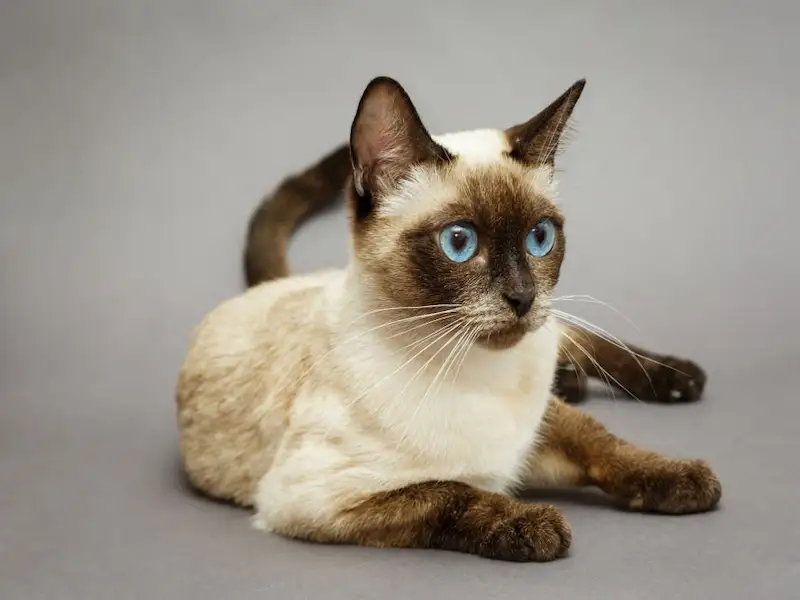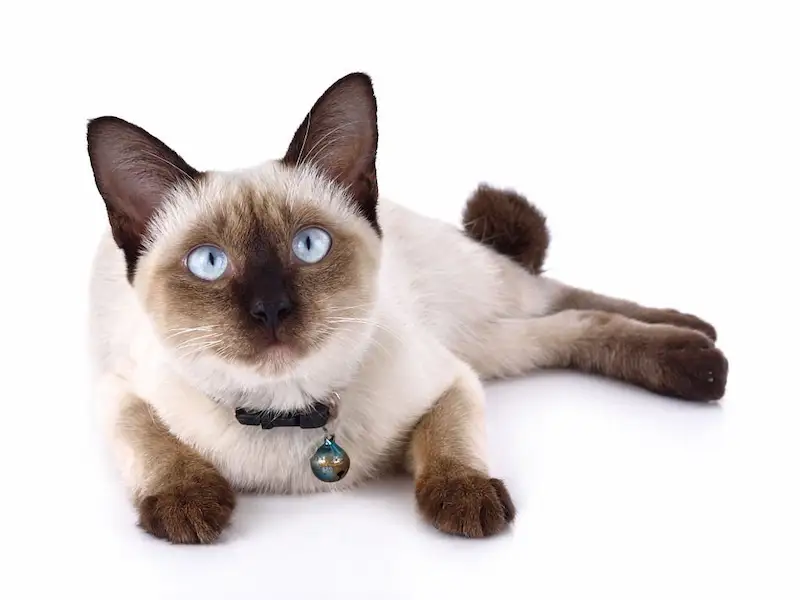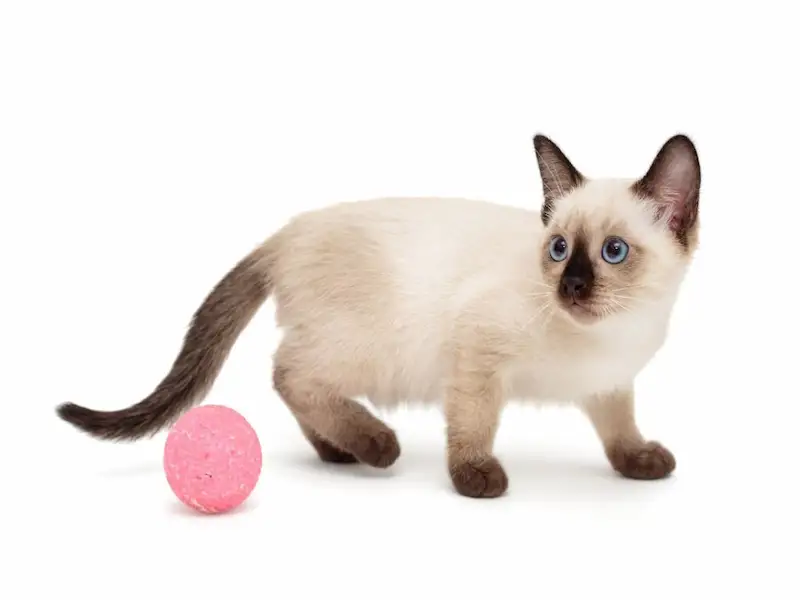Siamese cats are known for their light brown body and dark brown socks and ears. They look pretty furry you ask. Can they really be hypoallergenic? Although no cat is purely hypoallergenic, Siamese cats are considered cats hypoallergenic. They’re not the most hypoallergenic of breeds, but people with mild to moderate cat allergies generally get along well with them.
Are Siamese Cats Hypoallergenic? Read this article to find out what actually causes allergies in cats and whether proper diet and care can help minimize allergic reactions in cat parents.
Cat Allergy Explained: What Are People Allergic To?
It’s a common misconception that people with cat allergies react to cat dander. Allergy sufferers do react to proteins, most notably Fel d 1, which is produced by cats’ sebaceous glands. This means that the cat contains allergens:
- urine and feces
- saliva
- tears
- Slimy
- skin and hair
Studies show that 80 to 95 percent of those allergic to cats react to the protein Fel d 1. Only a small percentage of humans respond to the Fel d 2 and Fel d 3 proteins, which are also produced by cats’ sebaceous glands. Because all kittens have these proteins, regardless of breed, coat length, and intensity of shedding, there are no hypoallergenic cat breeds.

Do Siamese cats cause severe allergic reactions?
Some breeds of cats, including Siamese, Bengal, Russian Blue, Burmese, Sphynx, and Siberian cats, do not produce large amounts of the protein Fel d1, so they may cause milder reactions in allergy sufferers. Not only do Siamese cats produce small amounts of this protein, but they also shed less fur. Because fur and cat dander contain allergens, cats that shed less hair seem to make better pets for allergy-prone cat parents.
RELATED: Ragdoll Cat Breed information profile, Characteristics & Care
Siamese Cats and Allergy Sufferers: Can They Live Together?
If you suffer from mild cat allergies, you can live with a Siamese cat without experiencing severe reactions. Antihistamines like loratadine can help control symptoms like these:
- inflammation of the nasal mucosa
- watery eyes
- Sneeze
- irritation of the throat
- itchy skin
It is possible to avoid medication altogether if certain precautions are taken, such as:
- Wash your laundry more often
- Don’t let your cat sleep in your bed or restrict its access to the bedroom.
- wash clothes often
- Daily vacuuming and dusting
- Keep washable covers for furniture
- Groom your cat outdoors with gloves and a mask, or ask someone else to groom you.
Doctors do not recommend adopting a cat if you are experiencing severe symptoms, including:
- Vomit
- swelling
- severe asthma
- Difficulty swallowing
Caring for your Siamese to control the exposure to allergens
You can significantly reduce shedding and the amount of hair (and allergens) in your home with proper care of your Siamese cat. You should:
- Clean your cat regularly
- Treat basic health problems
- Invest in quality food
How to care for a Siamese cat

Regular grooming will help remove dead hair and skin and prevent allergens from spreading throughout the home. Brushing several times a week should be sufficient.
Sweep away, Hooman, while he can get some time outside.
Here are some tips to keep in mind:
- Brush your Siamese outside: cat hair is so fine it flies everywhere. Brushing your Siamese outside will keep dead fur and hair out of your home. Always brush in the direction of hair growth, using a soft-bristled or rubber brush. You can also ask someone who is not allergic to cats to brush for you.
- Clean your cat’s fur with a damp cloth: this will ensure that the dead fur and remaining hair adhere to the cloth.
- Bathe your Siamese regularly: You should bathe your feline friend once a week. Start washing when your cat is a kitten so she can get used to the whole process.
RELATED: 10+ FACTS ABOUT TUXEDO CATS [PERSONALITY, HISTORY, Characteristics & Care Health
How can health problems affect filing?

Siamese cats are prone to two diseases that can cause excessive shedding:
- Psychogenic Feline Alopecia: Siamese cats are prone to compulsive behaviors, such as B. Excessive grooming, which can cause them to lose their hair in places. The main causes of this condition include chronic stress, psychological trauma, anxiety, and boredom. Treatment usually includes lifestyle changes and antidepressants
- Feline Hyperesthesia Syndrome: Also known as skin contraction syndrome, this condition is common in Siamese, Burmese, and Abyssinian cats. Their skin becomes extremely sensitive, causing them to lick, bite, and scratch excessively, which can lead to open sores. The condition can be caused by:
- fungal infections
- parasites
- food allergies
- Allergies to particles in the environment
How can quality cat food help treat cat allergies?
Inadequate nutrition can increase fur production in cats and increase your exposure to allergens. The following ingredients, commonly found in commercial cat food, are particularly problematic:
- Additives—artificial flavoring and colorants
- Common allergens: eggs, dairy, beef
- Filling Ingredients: Grains, such as rice, corn, wheat, soy, etc.
To reduce shedding and prevent many skin problems, you should give your cat food that matches its natural eating habits. In nature, cats hunt and eat small animals like birds, mice, and snails. The food you feed them should mimic this, it should contain an appropriate proportion:
- Adequate Amounts of Appropriate Protein: Cat food should contain at least 50 percent animal protein, as meat is the only source of essential amino acids like taurine, arginine, and histidine, which cats need for healthy skin and coats. These amino acids also support the immune system and help build muscle and bones. Because cats are carnivores, plant-based diets and protein from vegetables are not right for their digestive systems. The best sources of protein for cats are lean meat (e.g. chicken, liver, turkey) or fish.
- Moderate amounts of fat – Animal fat is not only a good extra source of energy for cats but also provides omega-3 and omega-6 fatty acids, which help ensure a healthy, shiny coat and less shedding. Fat also helps with dry skin, plays an important role in metabolic processes, and is essential for wound healing and the proper inflammatory response. Tuna, sardines, salmon, and mackerel are good sources of essential fatty acids.
- Vitamins and minerals: Vitamin B complex, vitamin E and selenium help moisturize the skin and are necessary for a healthy cat coat. All essential vitamins and minerals are contained in meat.
Wet Food vs. Dry Food: What’s Best for a Siamese Cat’s Coat?
Many vets recommend feeding wet food instead of dry food and giving your kitten at least two servings of canned food per day:
- Keeps the cat hydrated
- Reduces the possibility of urinary problems
- Contains more protein
- Helps moisturize your cat’s skin
Unlike dry food, which only contains 10 percent moisture, wet food generally has a moisture content of around 70 percent. This is important because cats are not very thirsty and dry food can cause them to become dehydrated. Dehydration can lead to loss of skin elasticity and hair growth.
In addition to hair problems, dehydration can also cause more serious health problems, such as urinary tract infections (such as struvite crystals and cystitis) and constipation.
Reduce hair growth in Siamese cats
A balanced diet can reduce shedding in Siamese cats.
you can manage your cat’s allergies more easily. Our wet cat food contributes to your cat’s overall health, nourishing its skin and coat and reducing shedding.
All of our sauce and jelly recipes are made with quality ingredients and are completely free of:
- meat derivatives
- Vegetable Proteins
- grains
- sugar
- additives
Discover the benefits of meals below:
Untamed can do more than just keep allergies at bay
meals are suitable for cats of all breeds, ages, and sizes.
- Ensure your kitten is developing properly by reaching a healthy weight with appropriate food portions.
- Keep your adult Siamese playful and fit by providing appropriate portions based on their breed, gender, and activity level
- Maintains a healthy weight and appetite in older cats and prevents loss of muscle tone
Hypoallergenic Qualities in siamese kittens
longhaired
It seems that cats with shorter hair are more hypoallergenic than cats with long hair. Science actually proves the opposite. Since we already know that humans aren’t necessarily allergic to cat dander, hair length shouldn’t matter much, right?
It has been found that the protein Fel d 1 is better contained in the skin and hair when the cat’s hair is longer. This means less protein is released into the air or onto other objects.
Low Shedding
Cats that shed less hair are less likely to release the Fel d 1 protein into the environment. Therefore, it is logical that a low-shedding cat would have better hypoallergenic characteristics than a high-shedding cat.
Female
Compared to their male counterparts, females gain less Fel d That means if you really want a cat, you should get one if you are prone to cat allergies.
More quick facts about Siamese cats
Siamese cats can be your new best friend if you are looking for a cat with hypoallergenic characteristics. These cats are extremely playful, affectionate, and loyal. Some would even describe their behavior as dog-like! You can have your very own purebred Siamese kitten for around $200. Make sure you give them plenty of entertainment in the form of toys and your attention.
How can I treat cat allergies?
People unfortunate enough to be allergic to cats can sometimes have serious reactions. These reactions can be severe enough to require you to go to the emergency room with trouble breathing. For this reason, allergy sufferers should have the appropriate medication on hand.
A visit to the doctor is the best solution. Depending on how severe your allergy is, the doctor may prescribe an adrenaline injection, allergy pills, or inhalers.
The best prevention is to avoid the source. However, if you can’t live without a kitten in your life, or you’ve found that you’re allergic to your best friend, you can try some of these strategies:
- Keep your bedroom door closed.
- Always wash your hands after handling your cat.
- Buy an air purifier.
- Vacuum frequently with a pet vacuum cleaner.
- Remove carpets and upholstery: Tile or wood floors help reduce allergens.
- Wash carpets and furniture covers in hot water frequently.
- Ask a non-allergic person to dust and clean the bedding regularly.
Here are some other things that can affect your Siamese cat’s allergy:
The age of your Siamese cats
People adopting a kitten can do fine in the initial stages until they start to grow. Kittens release less Fel D1 than adult cats. Many people think that they have suddenly developed an allergy to cats, but that is not the case.
It’s always best to do an allergy test before bringing a cat home. Otherwise, you may have to take your adorable kitty home with you after just a few weeks. This will not only be sad for you but also difficult for your pet.
Luckily, there are some ways to overcome mild allergies.
Gender of Your Siamese
Female cats tend to emit less Fel D1 than males. By choosing to adopt a female Siamese rather than a male from another breed, you can reduce the chance of an allergic reaction.
Remember that male and female cats have different personalities. Also, they need multiple surgeries to avoid unwanted litter.
Does Grooming a Siamese Cat Make Them Hypoallergenic?
By grooming your cat regularly and properly, you can help reduce allergens even further. Many cats are uncooperative when bathing, but fortunately, Siamese cats love water very much. Up to three baths per week may be necessary to keep the allergens in the house low.
What is a lynx point Siamese cats?
The Lynx Point Siamese is one of the most popular types of Siamese cats. These cats are known for their striking blue eyes and pointy ears, which give them a decidedly fierce look. Lynx Point Siamese are also relatively large cats, with males typically weighing around 15 pounds.
siamese kittens for sale: click here
Conclusion
It can be an ironically difficult life when you love cats but are also allergic to them. Depending on the severity of your allergies, you could still own a cat and remain healthy. One way is by purchasing a cat with hypoallergenic qualities, like the Siamese cats. Though they are not 100% hypoallergenic (no cat is), they are very low on the list of cat breeds that are offensive to allergy sufferers.


